|
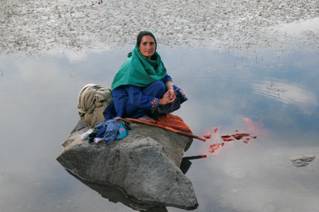
Saturday August 30: Phandur – Mastuj
The hotel insisted on bringing a large bowl of porridge for
breakfast (which no one touched) to go with the toast, chapattis, butter and
jam. The toast was actually non-mouldy and crisp.
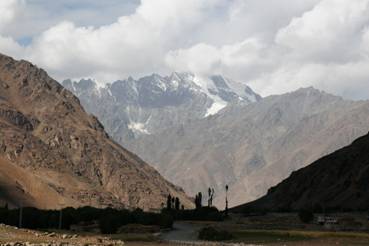 After an hour,
at Teru, the road towards the Shandur Pass & Chitral gives up and becomes a
track again. Somehow (naively obviously) I had imagined that as it was a main
road and linked two major towns, viz. Gilgit and Chitral, it would be metalled
all the way to Chitral. It was a bit of a shock to be back on tracks again
after several days on metalled roads. The climb up to the Shandur Pass is very pretty with snow capped peaks rising to 6,900meters on both sides of the road. The
track gets really rather steep and narrow towards the top; I suppose I really
should not have been surprised but you hold visions of things in your mind that
are different to the reality. We passed a NATCO bus (not a minibus)
going towards Gilgit and I again I suppose by then I shouldn’t have been, but I
was amazed how it managed to get there – especially as the road on the Chitral
Side of the pass is even steeper and narrower. After an hour,
at Teru, the road towards the Shandur Pass & Chitral gives up and becomes a
track again. Somehow (naively obviously) I had imagined that as it was a main
road and linked two major towns, viz. Gilgit and Chitral, it would be metalled
all the way to Chitral. It was a bit of a shock to be back on tracks again
after several days on metalled roads. The climb up to the Shandur Pass is very pretty with snow capped peaks rising to 6,900meters on both sides of the road. The
track gets really rather steep and narrow towards the top; I suppose I really
should not have been surprised but you hold visions of things in your mind that
are different to the reality. We passed a NATCO bus (not a minibus)
going towards Gilgit and I again I suppose by then I shouldn’t have been, but I
was amazed how it managed to get there – especially as the road on the Chitral
Side of the pass is even steeper and narrower.
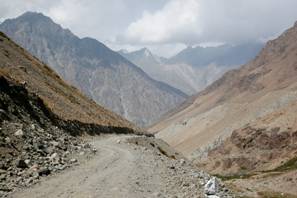 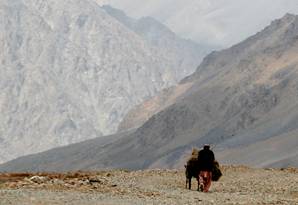 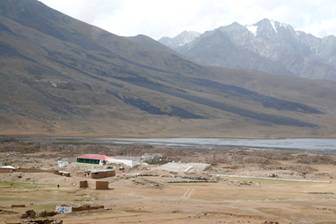 The Shandur Pass is at 3,700metres (12,300ft) and is fairly broad – I
suppose it would have to be to have a Polo ground. In fact to be honest, other
than travelling from Chitral to Gilgit (or the villages in between) Polo is the
only real reason you would travel there. There is an annual Polo festival
between Gilgit and Chitral held every June, and thousands of people turn up,
including political big-wigs who helicopter in. It’s not as though the Shandur Pass is near to either town, though it is roughly halfway, and takes about 9 hours
from either. No, the horses are not driven there in horse boxes, they are
ridden there over the period of a week or two; they even play the odd game on
the way. So, for a week of so in June, the pass is covered by hundreds of tents
and food stalls; for the rest of the time it is a fairly windy desolate place –
or it was when we were there. There is a sort-of permanent, sort-of grandstand,
and an enterprising group have set up summer food tents to victualise the
passing travellers. Eshan and Eidjan had tea and yoghurt, but we declined. The
original itinerary had us camping on the Shandur Pass, but to be honest you
would only do so at Polo time, in any case it was cold and blowing a gale when
we were there and we had already decided to have an extra night in Chitral. In
fact because we could not go to Peshawar for safety reasons, we had had to
rearrange the final few days of our trip somewhat. The Shandur Pass is at 3,700metres (12,300ft) and is fairly broad – I
suppose it would have to be to have a Polo ground. In fact to be honest, other
than travelling from Chitral to Gilgit (or the villages in between) Polo is the
only real reason you would travel there. There is an annual Polo festival
between Gilgit and Chitral held every June, and thousands of people turn up,
including political big-wigs who helicopter in. It’s not as though the Shandur Pass is near to either town, though it is roughly halfway, and takes about 9 hours
from either. No, the horses are not driven there in horse boxes, they are
ridden there over the period of a week or two; they even play the odd game on
the way. So, for a week of so in June, the pass is covered by hundreds of tents
and food stalls; for the rest of the time it is a fairly windy desolate place –
or it was when we were there. There is a sort-of permanent, sort-of grandstand,
and an enterprising group have set up summer food tents to victualise the
passing travellers. Eshan and Eidjan had tea and yoghurt, but we declined. The
original itinerary had us camping on the Shandur Pass, but to be honest you
would only do so at Polo time, in any case it was cold and blowing a gale when
we were there and we had already decided to have an extra night in Chitral. In
fact because we could not go to Peshawar for safety reasons, we had had to
rearrange the final few days of our trip somewhat.
As noted earlier, it is a really steep and narrow track down
from the pass towards Chitral. At the bottom of the pass we stopped for a lunch
of biscuits, dried mulberries and nuts – a bit sparse. This side of the pass is
notably drier and more closed-in and with less irrigation, and the farming is
consequently poorer – the fact that the fields are smaller is particularly
noticeable.
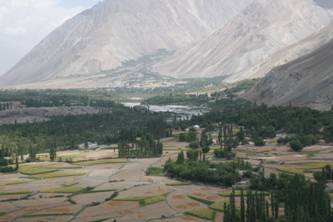 By By 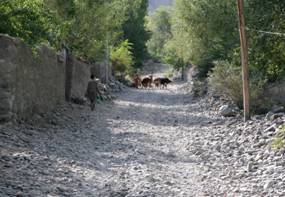 the junction of the road (road! – rough track!) we stopped for
diesel, which was duly delivered by a hand-operated pump. the junction of the road (road! – rough track!) we stopped for
diesel, which was duly delivered by a hand-operated pump.
The village of Mastuj is built on a vast expanse of river
gravels which are criss-crossed by irrigation channels and so there are lots of
trees and farms. Whilst most Pakistan villages have an identifiable centre,
Mastuj does not, it is a collection of houses and shops that are spread out
between the trees growing on thick river gravels. Thus the track through the
village is nothing more really than largely ungraded river gravels. We were due
to stay at the Mastuj Fort, which sounded quite romantic. No, not really. The
‘fort’ bit really was just a section of mud-brick wall within which there were
a number of cabins. We eventually raised the janitor, or manager of whatever he
was (he looked at least 80), but the whole place looked like it had not been
used for weeks, so we decided to stay at the PTDC up the track. In fact the
place could have been very nice, and indeed, romantic if used and up kept, and
the distinct lack of tourism clearly did not help. We later discovered that it
is actually owned by the same people who own and run the excellent Hindu Kush Heights hotel in Chitral – apparently you make a booking through the HKH and
they dispatch staff to Mastuj to look after you. Perhaps that accounts for
things.
As we were starving, we sat in the hotel grounds and had
green tea and lots of biscuits; all quite pleasant with the breeze ruffling the
trees.
|

 After an hour,
at Teru, the road towards the Shandur Pass & Chitral gives up and becomes a
track again. Somehow (naively obviously) I had imagined that as it was a main
road and linked two major towns, viz. Gilgit and Chitral, it would be metalled
all the way to Chitral. It was a bit of a shock to be back on tracks again
after several days on metalled roads. The climb up to the Shandur Pass is very pretty with snow capped peaks rising to 6,900meters on both sides of the road. The
track gets really rather steep and narrow towards the top; I suppose I really
should not have been surprised but you hold visions of things in your mind that
are different to the reality. We passed a NATCO bus (not a minibus)
going towards Gilgit and I again I suppose by then I shouldn’t have been, but I
was amazed how it managed to get there – especially as the road on the Chitral
Side of the pass is even steeper and narrower.
After an hour,
at Teru, the road towards the Shandur Pass & Chitral gives up and becomes a
track again. Somehow (naively obviously) I had imagined that as it was a main
road and linked two major towns, viz. Gilgit and Chitral, it would be metalled
all the way to Chitral. It was a bit of a shock to be back on tracks again
after several days on metalled roads. The climb up to the Shandur Pass is very pretty with snow capped peaks rising to 6,900meters on both sides of the road. The
track gets really rather steep and narrow towards the top; I suppose I really
should not have been surprised but you hold visions of things in your mind that
are different to the reality. We passed a NATCO bus (not a minibus)
going towards Gilgit and I again I suppose by then I shouldn’t have been, but I
was amazed how it managed to get there – especially as the road on the Chitral
Side of the pass is even steeper and narrower.

 The Shandur Pass is at 3,700metres (12,300ft) and is fairly broad – I
suppose it would have to be to have a Polo ground. In fact to be honest, other
than travelling from Chitral to Gilgit (or the villages in between) Polo is the
only real reason you would travel there. There is an annual Polo festival
between Gilgit and Chitral held every June, and thousands of people turn up,
including political big-wigs who helicopter in. It’s not as though the Shandur Pass is near to either town, though it is roughly halfway, and takes about 9 hours
from either. No, the horses are not driven there in horse boxes, they are
ridden there over the period of a week or two; they even play the odd game on
the way. So, for a week of so in June, the pass is covered by hundreds of tents
and food stalls; for the rest of the time it is a fairly windy desolate place –
or it was when we were there. There is a sort-of permanent, sort-of grandstand,
and an enterprising group have set up summer food tents to victualise the
passing travellers. Eshan and Eidjan had tea and yoghurt, but we declined. The
original itinerary had us camping on the Shandur Pass, but to be honest you
would only do so at Polo time, in any case it was cold and blowing a gale when
we were there and we had already decided to have an extra night in Chitral. In
fact because we could not go to Peshawar for safety reasons, we had had to
rearrange the final few days of our trip somewhat.
The Shandur Pass is at 3,700metres (12,300ft) and is fairly broad – I
suppose it would have to be to have a Polo ground. In fact to be honest, other
than travelling from Chitral to Gilgit (or the villages in between) Polo is the
only real reason you would travel there. There is an annual Polo festival
between Gilgit and Chitral held every June, and thousands of people turn up,
including political big-wigs who helicopter in. It’s not as though the Shandur Pass is near to either town, though it is roughly halfway, and takes about 9 hours
from either. No, the horses are not driven there in horse boxes, they are
ridden there over the period of a week or two; they even play the odd game on
the way. So, for a week of so in June, the pass is covered by hundreds of tents
and food stalls; for the rest of the time it is a fairly windy desolate place –
or it was when we were there. There is a sort-of permanent, sort-of grandstand,
and an enterprising group have set up summer food tents to victualise the
passing travellers. Eshan and Eidjan had tea and yoghurt, but we declined. The
original itinerary had us camping on the Shandur Pass, but to be honest you
would only do so at Polo time, in any case it was cold and blowing a gale when
we were there and we had already decided to have an extra night in Chitral. In
fact because we could not go to Peshawar for safety reasons, we had had to
rearrange the final few days of our trip somewhat. By
By  the junction of the road (road! – rough track!) we stopped for
diesel, which was duly delivered by a hand-operated pump.
the junction of the road (road! – rough track!) we stopped for
diesel, which was duly delivered by a hand-operated pump.